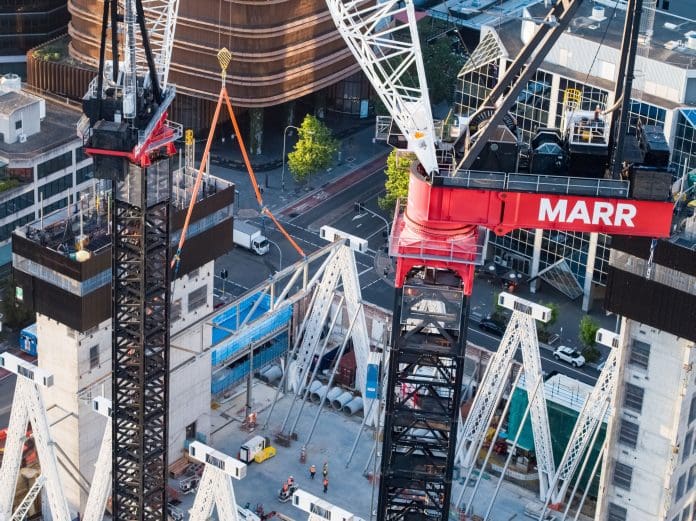Offsite manufacturing has been hit by a number of high-profile company closures. Could doors opened by the UK-Australia Free Trade Agreement allowing larger, record-breaking cranes from Australia to boost the sector by allowing for bigger, bolder modular projects?
Offsite manufacturing was once considered the UK’s solution to the industry’s carbon problem, with modular construction cutting emissions while also providing a safer and quicker project delivery.
However, following a succession of high-profile company closures, the current offsite manufacturing scene in the UK seems relatively bleak in comparison. The collapse of major modular firms raised concerns about the sector’s financial stability, with rising material costs and inflation making project financing more difficult.
During this time, the offsite construction scene was getting stronger and gaining confidence internationally, with many major projects giving the nod to modular construction.
The larger cranes from Australia allow for large-scale offsite construction
Global heavy lifting tower crane specialist Marr Contracting has been changing how modular construction is approached by providing bigger and simpler craneage solutions.
This methodology enables construction teams to transport larger prefabricated parts to the site, allowing for large-scale offsite construction to take place.
Instead of lifting many smaller pieces, one piece at a time, modules and upsized components can be assembled offsite and then placed through a few major crane lifts. This means more control (and safety), assembling sections on the ground and installing them in one lift rather than welding multiple sections at height.
Larger cranes ensure fewer cranes are required on-site and the increased capacity and reach mean fewer lifts are necessary.
A decongested work site is not only safer but also increases productivity and reduces temporary groundworks.
Opening the door
The UK-Australia Free Trade Agreement, signed in December 2021, is providing opportunities for businesses in Australia, like Marr, to move into the UK market and offer their solutions.
For Marr, which has previously worked with Balfour Beatty on the Hinkley Point C Tunnelling & Marine Project in the UK, it has opened the door to a strong pipeline of major infrastructure projects that will soon see their record-breaking cranes appearing all over the country.
Marr’s experience in the successful delivery of large-scale projects in Australia and the Middle East is ideally suited to supporting emerging trends and policies aimed at encouraging MMC in the UK.
Its expansion in the UK will create the potential for modern methods of construction (MMC) in large-scale projects, where previously modular options have been limited by the potential weight of lifts and feasibility issues.
Marr has recently started working with Black & Veatch on the Lostock Sustainable Energy Plant (LSEP) in Cheshire, which, upon completion, will have the capacity to produce enough power for 125,000 homes. Marr developed a two-crane solution utilising the world’s largest capacity luffing tower crane, the M2480D.
This solution offered a lift capacity of up to 110 tonnes and a reach of up to 73m, supporting MMC construction by allowing larger sections of plant and equipment weighing up to 85 tonnes to be installed in fewer lifts.
How will design teams and contractors benefit from Marr’s approach?
Design teams and constructors also gain the benefit of more freedom and surety of vision with Marr’s approach.
Powerhouse Parramatta will be the largest museum in New South Wales at 30,000 sq m upon completion and is currently one of the largest structural engineering and architecturally complex projects underway in Australia.
With the structural support for the trusses that achieve a column-free exhibition space sitting on the exterior of the building, the challenge from a construction point-of-view was how to install the heavy steel trusses and deliver the project to the architectural team’s vision.
In the development of the Sydney project, Lendlease consulted Marr early in the planning stage and was able to develop the craneage solution around its preferred construction methodology rather than being driven by the limitations of the crane. As a result, site work included lifting heavier modularised sections of the exoskeleton, including steel trusses weighing up to 120 tonnes in a single lift.
Bigger, bolder projects
Designing without having to consider traditional craneage limitations allows for projects to become bigger and bolder, which was evident in the construction of the world’s longest-span suspension bridge, the 1915 Çanakkale Bridge in Turkey.
Stretching 4.6km long and connecting Europe with Asia, the project team from the DL E&C-Limak-SK ecoplant-Yapi Merkezi Joint Venture (DLSY JV) approached Marr looking for a craneage solution to match how they wanted to construct the project.
Marr’s solution required out-of-the-box thinking to bring the vision to life and included eight 160-tonne lifts, as well as over 35 150-tonne lifts.
The solution resulted in the bridge opening more than 12 months ahead of schedule. By modularising the structure into larger, heavier sections, the solution reduced the number of lifts and the overall construction schedule, with fewer site-based activities and a higher level of on-site safety.
By bringing these solutions to the UK market, more ambitious modular design and construction can now be considered in major projects. Project schedules can be shortened, construction simplified and safety improved.
Marr Contracting
Tel: +44 (0)7930 271 791

















